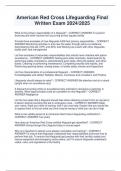American Red Cross Lifeguarding Final
Written Exam 2024/2025
What is the primary responsibility of a lifeguard? - CORRECT ANSWER-To prevent
drowning and other injuries from occurring at their aquatic facility
Provide three examples of how lifeguards fulfill their primary responsibility. - CORRECT
ANSWER-Monitoring activities in and near the water through patron surveillance,
Administering first aid, CPR, and AED, and Working as a team with other lifeguards,
facility staff, and management
List five examples of secondary responsibilities that should never interfere with patron
surveillance. - CORRECT ANSWER-Testing pool water chemistry, Assist patrons by
performing safety orientations, administrating swim tests, fitting life jackets, and other
duties, Cleaning or performing maintenance, Completing records and reports, and
Performing opening duties, closing duties, or facility safety checks and inspections
List five characteristics of a professional lifeguard. - CORRECT ANSWER-
Knowledgeable and skilled, Reliable, Mature, Courteous and consistent, and Positive
Lifeguards should always do what? - CORRECT ANSWER-Be attentive and sit or stand
upright when on surveillance duty
A lifeguard is texting while on surveillance duty and fails to recognize a swimmer in
distress. What legal principle could be a problem for this lifeguard? - CORRECT
ANSWER-Negligence
List the five steps that a lifeguard should take when obtaining consent from an injured or
ill person before providing first aid or emergency care. - CORRECT ANSWER-State
your name, State your level of training, Ask if you may help, Explain that you would like
to assess them to find out what you think may be wrong or what you can do to help
What is the validity period of an American Red Cross Lifeguarding certification? -
CORRECT ANSWER-Two years
How does an American Red Cross certified lifeguard get recertified? - CORRECT
ANSWER-Going through the Lifeguard class or course again
Why is it important to attend a pre-season orientation and training? - CORRECT
ANSWER-To ensure that lifeguards understand their responsibilities and know how to
perform their job, To ensure that lifeguards get practice with their facility's safety and
rescue equipment and emergency action plans, and To ensure lifeguards understand
codes, rules, and regulations of the facility
, What does EAP stand for? - CORRECT ANSWER-Emergency Action Plan
Why is it important for lifeguards and other team members to understand and practice
the EAP? - CORRECT ANSWER-So everyone knows their responsibilities and can
perform them effectively
What is the best practice for the frequency of in-service training participation at well-
managed aquatic facilities? - CORRECT ANSWER-At least four hours of in-service
training each month
What are four topics that could be a discussed during in-service training? - CORRECT
ANSWER-Surveillance and recognition, Water and land rescue skills, Emergency
response drills, and Decision-making protocols (or Facility rules and regulations,
Customer service, Records and reports, and Physical conditioning)
What are the benefits of regular, frequent in-service training? - CORRECT ANSWER-
Helps you maintain your knowledge and skills at a professional level, gives you a
chance to practice with other lifeguards at your facility, and it will help you to efficiently
respond as a team in an emergency
In a water park setting, what additional items might be included in a safety checklist? -
CORRECT ANSWER-Inspecting and test run of rides and slides, Checking that rafts,
tubes, and/or sleds are properly inflated and the handles are secure, Landing areas are
free of rough surfaces and debris, Water level and flow is appropriate for attraction, and
Electronic dispatch systems are tested and are operating properly
Why should water parks have signs posted at every attraction stating the water depth? -
CORRECT ANSWER-To prevent patrons from finding themselves in water that is
deeper or shallower than they expected
What rules are typically covered at water park attractions? - CORRECT ANSWER-The
minimum or maximum number of people allowed on an attraction or tube at a time, The
maximum and minimum height or weight requirements for patrons using an attraction,
Rules for winding rivers, No jumping or diving into the water, No climbing on any
features, Rules for water slides, and No stacking of tubes or life jackets
What are some factors that make lifeguarding water parks different than typical pool? -
CORRECT ANSWER-Various attractions, Ride Vehicles, Currents on attractions,
Potentially larger crowds, and Different rules and EAPs
What items are considered to be personal protective equipment for a lifeguard? -
CORRECT ANSWER-Gowns, Shields, Resuscitation masks, Gloves, and Protective
Eyewear




